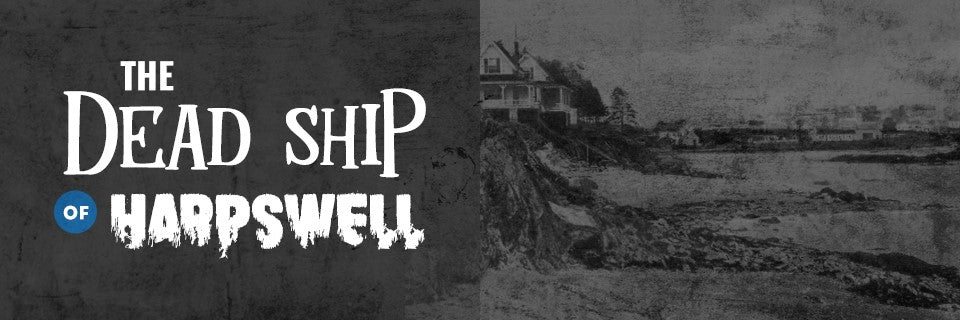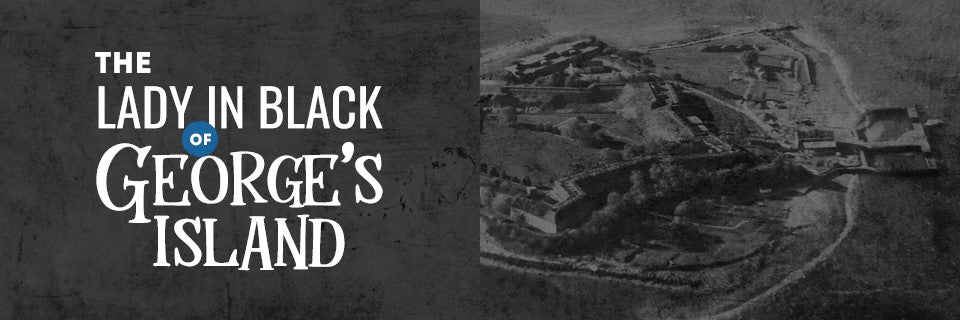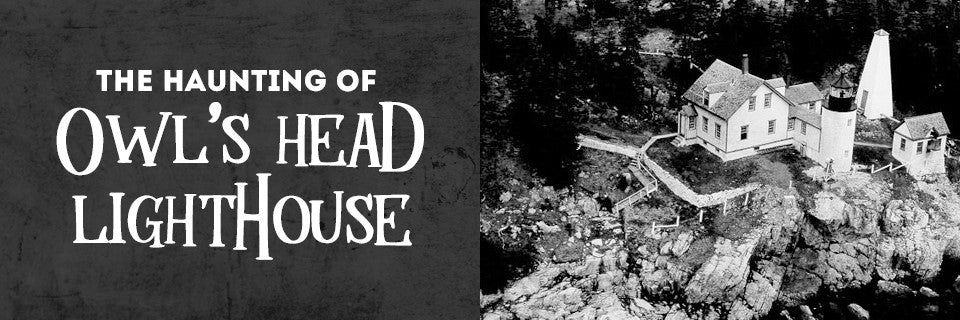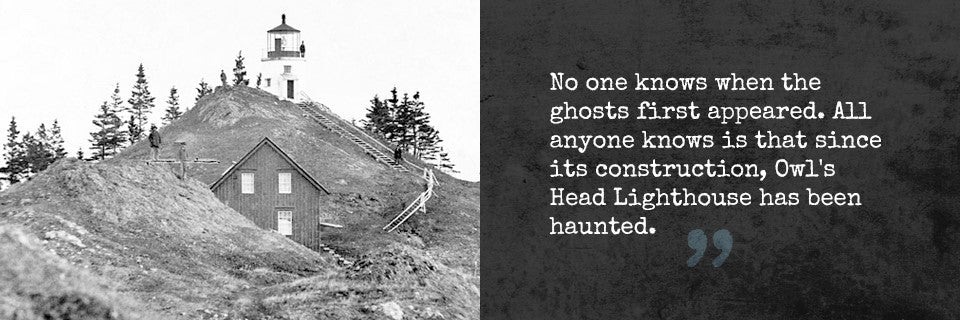New England overflows with ghost stories.
From the Salem witch trials to the tale of Mercy Brown, Rhode Island's vampire, the cold and forested New England states are a perfect backdrop for frightening events. Even small northern states like New Hampshire and Vermont have more than their share of ghost stories.
But perhaps the eeriest legends come from the coast.
Maybe it's because of its mystery and unpredictability, but the ocean seems to attract legends and stories. The gray and stormy New England coast is filled with unexplained phenomena — almost every community has stories of ghosts, from remote lighthouses to wind-swept islands.
Here are four of New England's most unnerving coastal legends, just in time for fall.
1. The Pirate Curse of Nix's Mate Island

If you venture out on the water of Boston Harbor, you might notice a small island with a curious and ominous beacon, 12 feet tall and 40 square feet at its base. The slip of land is no more than 200 square feet, and a small gravelly beach is exposed during low tides.
This little island is called Nix's Mate, and it wasn't always small. In 1636, the island was over 12 acres long, and the property was sold to a man from Boston named John Gallop. For Gallop, the place was perfect for grazing a small herd of sheep. But to the local authorities, the island was perfect for another reason.
Stretching near the mouth of the wide harbor, Nix's Mate was the ideal place to hang pirates.
According to custom, after hanging, the bodies of convicted pirates were often displayed in a visible location to send a message — piracy wouldn't be tolerated in these waters. Because of the island's location, many ships entering the harbor would pass close enough to see Nix's Mate, along with the bodies and bones swaying in the sea breeze. And since Boston harbor teemed with pirates during the late 17th and early 18th century, the hanging posts on Nix's Mate were almost always occupied.
In the 1630s, a sea-weary ship moored in the harbor, close to the island. After a long journey, the crew gratefully enjoyed a night of rest in the safety of the harbor. But the next morning, the captain, Nix, didn't emerge from his cabin. Curious, one of the crew knocked on his door, then cautiously entered the room. Nix was dead, murdered in his sleep.
The authorities were notified as soon as the crew got ashore, and the captain's first mate was convicted of the crime. The man swore his innocence, but it didn't sway the opinions of the court or crew. A crowd gathered at the hanging island, and as the hangman slid the noose around his neck, the mate cried to God, "Show that I am innocent! Let this island sink into the sea to prove that I have never committed murder!" His words hung in the air, unnerving the crowd as they returned to their homes.
Life returned to normal for the town and harbor. But as the years passed, significant chunks of the island were carried away by waves, until only a few pieces of rocky shoal remained. Gradually, the little island became known as Nix's Mate in honor of the innocent man wrongfully condemned.
According to some folklore, the island came by its name a different way. In this version, Captain Nix was a pirate who sailed into Boston Harbor for sanctuary. In 1680, Nix anchored in the harbor, his ship full with treasure stolen from unarmed merchants. During the night, he piled his wealth into a small boat and set off for the nearby island, accompanied by his loyal first mate.
After the mate dug a deep pit, they began to toss in bags of coin and jewels. As the mate's back was turned, Nix calmly pulled out his pistol and shot him — he buried the man with his treasure, sure that no one else knew its location. But his betrayal offended the sea, and gradually, she reclaimed both the island and Nix's treasure, and his restless ghost is said to still search for it among the rocks.
Another story claims the island's name has a less-bloody origin. In 1700, a ship anchored offshore of the small island. The day was overcast, and a dense mist drifted over the water. Waves slapped the cliffs of the island in strange rhythms, and the sound seemed so eerily abnormal that a Dutch passenger, leaning against the deck's railing, whispered that it was nixie scmalt, or "the wail of the water spirits." The incident unnerved him enough that he included the nixie scmalt island in a letter home that same year.
We will probably never know for certain what happened on Nix's Mate, but many claim that a presence hovers over the small isle. Whether it belongs to a bitter mate, a wandering captain, ancient sea spirits or just the restless souls of countless condemned pirates, something has made the little island stand out in local legend, and that something still lingers on the little island in the harbor.
2. The Dead Ship of Harpswell

Something about Maine's gray and rocky coast seems to attract unexplained stories of spirits and phantoms. One of the legends that still echoes along the shore is Harpswell's ghost ship.
No one expected the Dash to sink. During the War of 1812, the United States needed good seamen badly. In 1814, President Madison commissioned the Dash as a privateering vessel, charged with plundering and harassing British merchants, settlements and ships.
In just one year, the ship and her crew earned an incredible record of 15-0, outrunning many enemy warships in the process. But winter in the north Atlantic is harsh, and in January of 1815, the Dash raninto a fierce storm. Heavy rain, dense mist and freezing spray from enormous waves overwhelmed the frantic crew. The churning sea pushed the ship onto Georges Bank, a vast shoal dangerously close to the surface.
Hidden by the storm and waves, the Dash sunk into the cold ocean. But neither her wreckage nor her crew was found washed up on shore in the following days. This led some locals to watch for the ship's return to her home port, swearing that she had not been lost. The Dash was almost unsinkable, after all — surely no storm could have wrecked her.
But years passed, and the Dash never sailed victoriously into port. One day, a worker on the docks of Harpswell, Maine, looked out towards the horizon. The sun had just set, and a thin mist was settling over the waves. Before his eyes, a ship drifted into view, as though it came from the fog itself.
The ship was gray and under full sail, and she was making straight for the town's port in Casco Bay. Her sails were filled by a non-existent wind, and the ship seemed to carry the mist with her as she flew across the bay towards the docks. But most frightening of all, not a single person could be seen on the deck or handling the sails. Before the stunned worker could cry out, the ship faded from view, just before slamming into the shore. She was gone as quickly and eerily as she had appeared.
The Dash seemed to have finally returned to her home port. In the following decades, the dead ship of Harpswell haunted the residents of the small Maine town. Every few years, a local townsperson would see the ship while walking the shore — always at dusk, always unmanned and always vanishing just moments before hitting land. At first, sightings were just frightening and mysterious, signs that the ship had not sunk peacefully. But gradually, new stories emerged in the town.
If some unlucky person spied the ghost ship in the bay, they had more than spirits to fear. According to reports, if you saw the Dash, someone you loved was about to die.

For years, the residents of Harpswell avoided walking too near the bay at dusk, afraid what they might glimpse in the mist. The story of the death ship spread, and in 1866, poet John Greenleaf Whittier dedicated an entire poem to the legend — The Dead Ship of Harpswell. In the poem, Whittier writes of a "ghost of what was once a ship" that is captained by the angel of death, bringing doom to those who glimpse her gray sails.
The last official sighting was in the 1880s when a guest to the town reported watching an unmanned ship glide into the bay. He mentioned it in passing to his companion, but by the time they glanced at the water, the ship had faded out of view.
However, if you ask locals, the dead ship still drifts into the old bay every few years, and almost always, a sighting precedes a sudden death in the community. No one knows what the Dash is seeking in Casco Bay, but something keeps sailing out of the mist, restless and searching.
3. The Lady in Black of George's Island

Like Nix's Mate, George's Island guards the mouth of the Boston Harbor. But unlike Nix's, this island is substantial — with 39 acres of permanent land and another 14 at low tide, George's Island was just the right size for a military fort.
In 1850, construction on Fort Warren was completed on the island. The fort proved useful as a patrol point and training grounds, and during the American Civil War, it began a new career housing Confederate prisoners of war. The harbor's cold and bleak winters were a shocking contrast to the warm south, and many of the prisoners found the island harsh and inhospitable.
In 1861, a young Confederate soldier named Andrew Lanier was brought to Fort Warren, and he set himself to enduring a New England climate. During the bleak winter, he managed to send his beloved wife, Melanie, a secret letter, telling her he was alive but imprisoned.
It took months for the letter to make its way south to Georgia, but as soon as she received the letter, Melanie decided she would go to her husband, and she would help him escape.
After careful preparations, Melanie set out on the long and dangerous journey to Hull, Mass. At Hull, she stayed in the home of a secret Confederate sympathizer. A coastal town, Hull was just a mile away from George's Island and Fort Warren. For hours every day, Melanie studied the fort, memorizing the patterns of guards and the prison's daily schedule.
It was winter again before she was ready to act. She gathered an old pistol and a pickaxe. Cutting off her hair, she pulled on old men's clothes. When night fell, a storm blew into the harbor. Ignoring the freezing wind and sea, Melanie slipped into a waiting dinghy and began rowing.
With the loud surf masking any noise, she hid her small boat among large rocks at one end of the island. Creeping through the shadows, Melanie began to whistle, as quietly as she could. It was an old, obscure Southern tune, one she and Andrew had always loved. After several long moments, a second whistle joined hers — Andrew signaled back. Using her hands to guide her, she felt her way until she found the outside wall of his cell. She managed to squeeze through one of the fort's small windows and into the arms of her husband.
The soldiers managed to hide her from the guards, and using the pickaxe, they began to tunnel to the center of the fort. The night before they would complete the tunnel, one of the men became careless and struck a particularly loud blow with the pickaxe. Before the prisoners could back out of the tunnel, the alarm was sounded, and guards discovered the entrance.
After the last soldier was accounted for, the guards turned away from the entrance. Unnoticed, Melanie crept from the tunnel. Before anyone could react, she pulled her pistol and held it against the head of the nearest soldier. But the man spun around and knocked the gun away, and in shock, her finger squeezed the trigger. After the deafening shot, Andrew fell to the ground — Melanie had accidentally killed her husband.
Guards escorted Melanie to a cell, condemned her as a spy and sentenced her to death by hanging. On the eve of her execution, Melanie summoned all of her dignity and requested to wear female clothing at her hanging. After searching the fort, all the guards could find was an old, black robe. Draped in black, Melanie climbed the steps of the gallows, obscured by the ocean's cold spray.
Melanie Lanier died and was buried on George's Island, still in her black robes. Just a few weeks later, a young guard on duty was staring off towards the dark and rough sea, watching for Confederate ships. Suddenly, he felt two cold hands around his neck. Wheeling around, the stunned soldier stared at a shrouded, black figure, who lunged at the man again before vanishing.
Soon after the guard's encounter, a late snow storm filled the island with drifts. After the storm stopped, the soldiers on duty were stunned to see the imprint of a lady's slipper in the fresh snow. The footprints led nowhere.

And so began the haunting of George's Island. According to the stories, a mysterious figure was routinely spotted wandering the grounds. During dark and overcast nights, on-duty sentinels would sometimes see a woman, dressed all in black, drifting across the shore. When spotted, the ghost slowly approached the terrified onlooker. Suddenly lashing out with supernatural speed, the Lady in Black would furiously push and scratch her victim before vanishing. It is said she only targets people in a soldier's uniform, still furious and heartbroken at the death of her husband.
Her appearances didn't stop with the end of the war. In the early 1900s, a soldier broke his ankle while trying to escape the Lady. Many visitors claim to see a figure in black wandering the dark corridors beneath the fort to this day, and during dark, overcast nights, some still notice a Lady in Black walking along the shore.
4. The Haunting of Owl's Head Lighthouse

Penobscot Bay needed a lighthouse. During the 19th century, lime trade in nearby Rockland, Maine, had exploded. Because so many ships were coming in and out of the harbor, the community petitioned the federal government to build a lighthouse. Their request was accepted, and construction began in 1824.
In 1825, the long-awaited lighthouse was finally completed. It cost a total of $2,707.79 and came with a property of seventeen and a half acres of headland. Although a relatively short lighthouse, Owl's Head is on high ground — at night the beam of light can be seen for sixteen miles in every direction.
The lighthouse gained its name from its cliffs. Two large indentations make the cliff face look like the face of an owl, watching the sea with wide eyes. Rockland is known for its beauty, and the picturesque lighthouse perches above green, wind-swept hills dotted with pines, the essence of coastal charm.

No one knows when the ghosts first appeared. All anyone knows is that since its construction, Owl's Head Lighthouse has been haunted.
But the ghosts of Owl's Head don't seem to be malicious. One of the ghosts is just known as "Little Lady." The form of a small child is often seen rummaging through the kitchen or staring out a window. Before or after seeing her, doors tend to slam unexpectedly and silverware rattles in its drawer, but for the most part, Little Lady is said to be a benevolent spirit who brings a feeling of peace instead of fear.
Another mysterious presence is thought to be the ghost of a former keeper. Large footprints of a workman's boots sometimes appear in mud or freshly fallen snow, always leading from the keepers' house to the old lighthouse. When the keepers would follow the footprints up the lighthouse steps, they would find the brass brightly polished, although they had not cleaned it recently.
Currently, the Owl's Head is operated by the Coast Guard. But a change in ownership hasn't reduced encounters. Denise Germann, the wife of a Coast Guard keeper, reports that one night her husband left their bed, remembering he had not covered some construction equipment outside. Soon after, Denise felt him return and asked him sleepily why he had left. He didn't answer her, so she rolled over and froze. Her husband was not in bed, but next to her was the indentation of a body, moving as though shifting into a comfortable position.
Denise thought she was dreaming and forced herself to go back to sleep. In the morning, she told her husband what she had dreamed. Unnerved, he told her that last night, as he had left the room, he had seen a cloud of smoke hovering just over the floor. Thinking it was fog, he kept walking, but it moved past him and into the bedroom — just before Denise awoke.
Just a few years later, the new keepers were awakened by their 3-year-old daughter Claire standing in their doorway. The little girl announced, "Fog's rolling in! Time to put the foghorn on!" Shocked, her parents stared at her — they were sure that they had never spoken those phrases around her. On questioning Claire, she told them that she had an imaginary friend, an old man dressed in a long blue coat and a seaman's cap. For as long as the family was stationed at Owl's Head, Claire claimed that she could see her friend wandering through the house.
Other keepers have seen a figure, dressed all in white, sitting at one of the home's windows. In the 1980s, a son of the current keeper swore that he would often wake up and see a woman sitting in his room, watching him. For whatever reason, Owl's Head attracts supernatural visitors, and they don't seem to go away with time.
A Taste of the Coast Delivered to Your Door

The New England coast brims with life and legend, from ghost ships to eerie lighthouses.
But as much as New England is known for its ghosts, its also known for its seafood. At Maine Lobster Now, we bring high-quality, fresh seafood straight to your door. If you are craving a non-spooky part of New England coastal culture, browse our premium products including Alaskan king crab and Maine lobster.




